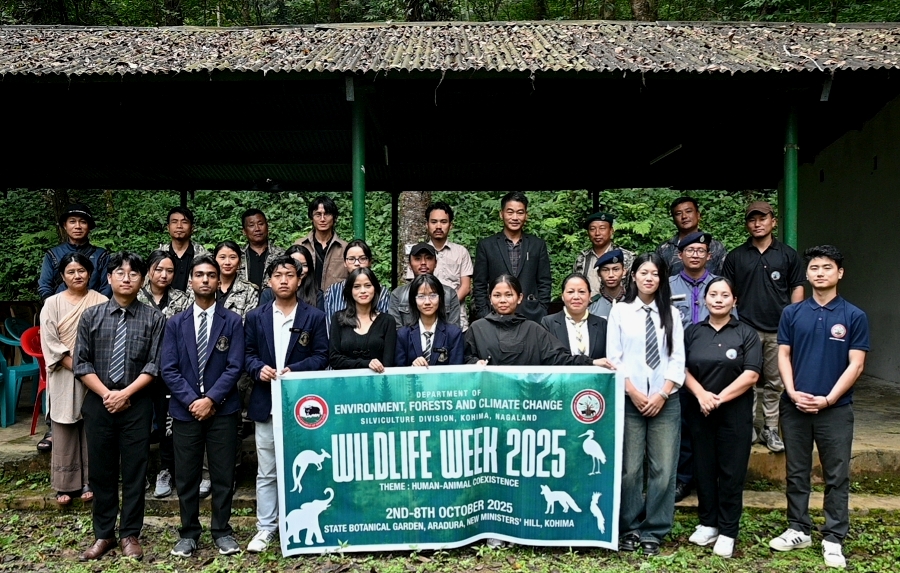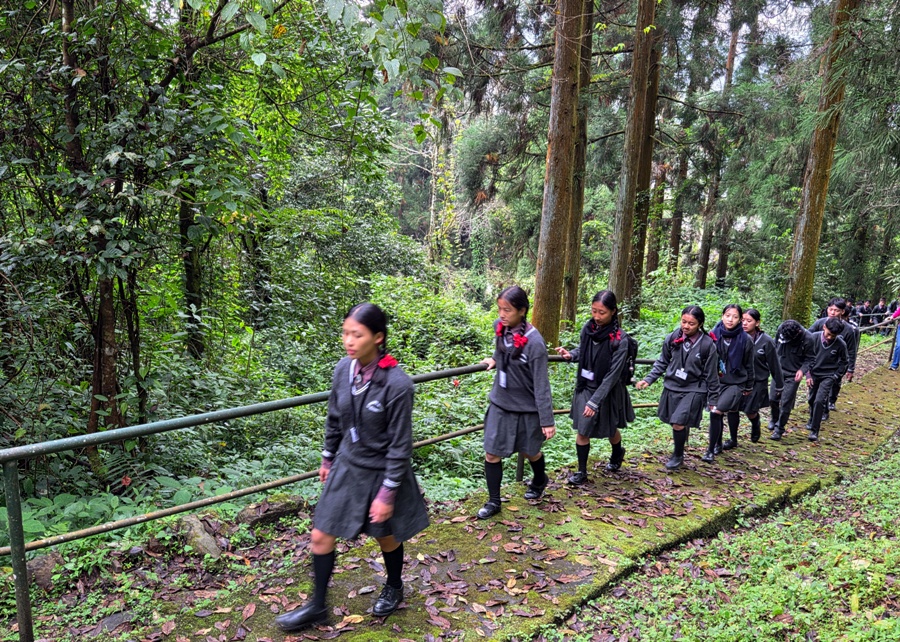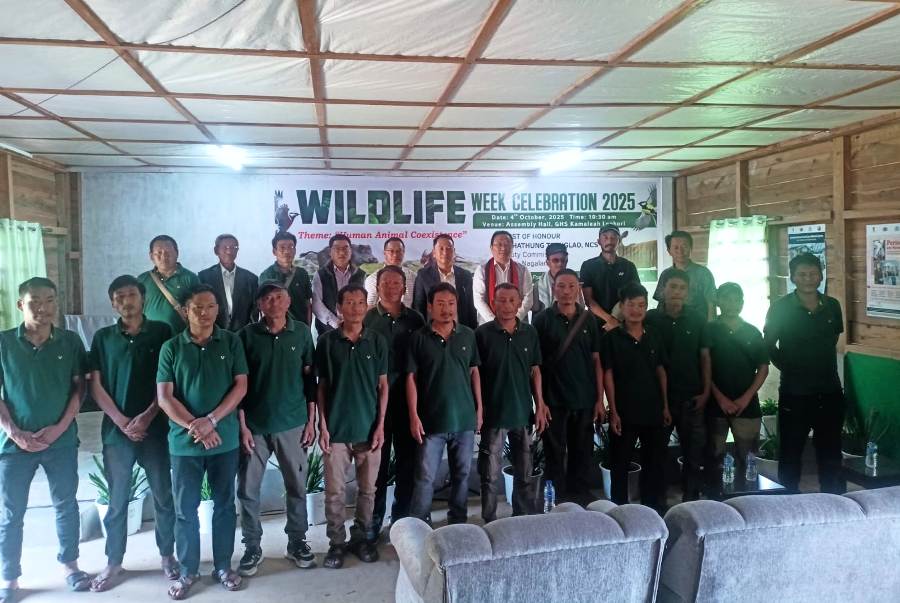Silviculture Division, Kohima commemorates Wildlife Week 2025 at State Botanical Garden, Kohima.
Share
Community-centric ‘Garden Adoption Initiative’ launched

DIMAPUR — The Silviculture Division, Kohima, under the Department of Environment, Forests & Climate Change, commemorated Wildlife Week 2025 on October 6 at the State Botanical Garden, Kohima, on the theme ‘Human–animal coexistence.’
The event featured a series of environmentally-focused activities, including a plantation drive, cleanliness campaign, awareness programmes, and the formal launch of the ‘Garden Adoption Initiative,’ a community-centric approach to conservation and beautification, an update stated.
Delivering the keynote address, Supongnukshi Ao, Chief Conservator of Forests (Biodiversity & Research) and Project Director of FBMP, highlighted the urgent need for public awareness and grassroots participation in wildlife conservation efforts.
Reflecting on traditional practices, the CCF stated, “We Nagas have historically regarded wildlife as a source of food and livelihood. However, such unsustainable practices pose a serious threat to species that were once abundant in our region.”
Supongnukshi stressed the ecological interconnectedness of all life forms, emphasising that “plants, animals, human beings, the earth, the environment, and water are all part of a single cycle-the food chain. If one link is broken, the entire system is affected.”
Also read: Phangnon Konyak to attend 80th UNGA session in New York
Addressing the growing concern of human–animal conflict, he attributed the rise in such incidents to deforestation, urban expansion, and the disruption of wildlife corridors, particularly those used by elephants.
The CCF also acknowledged the positive strides being made through initiatives like the ‘Airgun Surrender Campaign,’ and lauded the role of NGOs, schools, and eco-clubs in driving conservation awareness.
“The power lies with the people... True coexistence is only possible when communities, institutions, and individuals work together,” he concluded.
A major highlight of the celebration was the launch of the Garden Adoption Initiative, introduced by Florence T Sangtam, Forest Ranger.
This initiative invites schools, colleges, NGOs, and civil society organisations to adopt and care for designated sections of the State Botanical Garden.
The first adopters included the Forestry Graduates’ Association of Nagaland, Nagaland Bharat Scouts and Guides, Nature’s Club, Kohima Science College, Jotsoma, and Eco-Warriors Nagaland.
Representatives from each group expressed their commitment to the initiative and commended the department’s efforts in fostering community stewardship of green spaces.
The programme concluded with a vote of thanks delivered by Jeiang Konyak, Forester-I. The programme was chaired by Sunep L Imsong, Forester-I, and commenced with an invocation by Tinu Pongen.
Students take part in ‘Nature Walk’

As a part of Wildlife Week celebration, the Kohima Forest Division organised a ‘Nature Walk’ and an awareness programme for Class X students of St. Peter’s School, Kohima, on Tuesday.
During the Nature Walk to Blyths Tragopan Conservation and Breeding Centre in Kohima, biologist Kanili Rhakho briefed the students about the distinct features of Blyths Tragopan, adding that Nagaland holds the biggest number of Blyths Tragoapan all over the world.
She mentioned that the Blyths Tragopan can also be found in other districts across Nagaland. Briefing about the breeding centre, Rhakho said that the centre provides conservation efforts to support the species' population.
During the awareness programme conducted at Forest office complex, Kohima, Zuthunglo Patton, Conservator of Forests (STC), in her keynote address, expressed hope that the Nature Walk generated some kind of enthusiasm to the students to learn about other wildlife also.
Read more: Nagaland government defers police recruitment for four non-Naga tribes pending enumeration
Talking about this year’s Wildlife Week theme ‘Human-animal coexistence,’ the conservator of forests said the theme encompasses all aspects of wildlife, where people and wildlife are part of the same ecosystem.
Patton also mentioned that Nagaland is situated in one of the biodiversity hotspots of the world, the Indo-Burma region, and added that some of the rare species can be found only in Nagaland.
She said that though the state is rich in biodiversity, their numbers are very few, adding that population of wildlife is becoming vulnerable due to hunting.
Dr. Sevono Seletsu, DFO & DMU Head Kohima, officiated the pledge taking, encouraging all participants to commit themselves to the cause of wildlife conservation and peaceful human–animal coexistence.
During the programme, the CF and DFO also gave away diaries published by Kohima Forest Division to all the participants.
Altogether, 38 students and two teachers took part in the programme.
Lephori village hosts Wildlife Week event

The management committee of Khrokhropfü Community Reserve Forest, Lephori village under Meluri district, in collaboration with the Phek Forest Division and the Wildlife Division of Kiphire, organised a Wildlife Week programme on October 4 at GHS Kamaleah in Lephori village.
According to an update, Deputy Commissioner of Meluri, K Mhathung Tsanglao, the guest of honour, spoke on wildlife conservation, human-animal coexistence, and sustainable eco-tourism.
The event saw active participation from village council chairmen of five villages, head GBs administrative officers, Forest department staff, social workers, villagers, and students.
Siechutho Katiry, Wildlife Warden of Kiphire Wildlife Division, delivered the keynote address, followed by a short speech from Enyiwekha Wezah, Divisional Forest Officer of Phek.
Speakers emphasised the importance of community involvement and sustainable eco-tourism practices as essential components of coexistence between humans and wildlife.
They stated that it is possible to minimise human-animal conflict through individual actions. Additionally, they stressed the urgent need to safeguard wildlife and natural habitats for future generations and called for collective responsibility in protecting wildlife and preserving the environment.
The event featured major competitions, including drawing, painting, photography, and a mini-marathon run for wildlife.